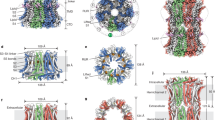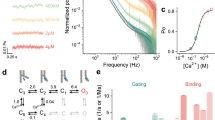Abstract
The calcium-release-activated Ca2+channel, ICRAC1,2,3, is a highly Ca2+-selective ion channel that is activated on depletion of either intracellular Ca2+ levels or intracellular Ca2+ stores. The unique gating of ICRAC has made it a favourite target of investigation for new signal transduction mechanisms; however, without molecular identification of the channel protein, such studies have been inconclusive. Here we show that the protein CaT1 (ref. 4), which has six membrane-spanning domains, exhibits the unique biophysical properties of ICRAC when expressed in mammalian cells. Like ICRAC, expressed CaT1 protein is Ca2+ selective, activated by a reduction in intracellular Ca2+ concentration, and inactivated by higher intracellular concentrations of Ca2+. The channel is indistinguishable from ICRAC in the following features: sequence of selectivity to divalent cations; an anomalous mole fraction effect; whole-cell current kinetics; block by lanthanum; loss of selectivity in the absence of divalent cations; and single-channel conductance to Na+ in divalent-ion-free conditions. CaT1 is activated by both passive and active depletion of calcium stores. We propose that CaT1 comprises all or part of the ICRAC pore.
This is a preview of subscription content, access via your institution
Access options
Subscribe to this journal
Receive 51 print issues and online access
$199.00 per year
only $3.90 per issue
Buy this article
- Purchase on Springer Link
- Instant access to full article PDF
Prices may be subject to local taxes which are calculated during checkout





Similar content being viewed by others
References
Lewis, R. S. Store-operated calcium channels. Adv. Second Messenger Phosphoprotein Res. 33, 279–307 (1999).
Parekh, A. B. & Penner, R. Store depletion and calcium influx. Physiol. Rev. 77, 901–930 (1997).
Clapham, D. E. Calcium signaling. Cell 80, 259–268 (1995).
Peng, J. -B. et al. Molecular cloning and characterization of a channel-like transporter mediating intestinal calcium absorption. J. Biol. Chem. 274, 22739–22746 (1999).
Putney, J. W. Jr Muscarinic, alpha-adrenergic and peptide receptors regulate the same calcium influx sites in the parotid gland. J. Physiol. (Lond.) 268, 139–149 (1977).
Lewis, R. S. & Cahalan, M. D. Mitogen-induced oscillations of cytosolic Ca2+ and transmembrane Ca2+ current in human leukemic T cells. Cell Regul. 1, 99–112 (1989).
Hoth, M. & Penner, R. Depletion of intracellular calcium stores activates a calcium current in mast cells. Nature 355, 353–355 (1992).
Kerschbaum, H. H. & Cahalan, M. D. Single-channel recording of a store-operated Ca2+ channel in Jurkat T lymphocytes. Science 283, 836–839 (1999).
Kerschbaum, H. H. & Cahalan, M. D. Monovalent permeability, rectification, and ionic block of store-operated calcium channels in Jurkat T lymphocytes. J. Gen. Physiol. 111, 521–537 (1998).
Zweifach, A. & Lewis, R. S. Mitogen-regulated Ca2+ current of T lymphocytes is activated by depletion of intracellular Ca2+ stores. Proc. Natl Acad. Sci. USA 90, 6295–6299 (1993).
Hoth, M. & Penner, R. Calcium release-activated calcium current in rat mast cells. J. Physiol. 465, 359–386 (1993).
Hille, B. Ionic Channels of Excitable Membranes (Sinauer Associates, Sunderland, MA, 1992).
Lepple-Wienhues, A. & Cahalan, M. D. Conductance and permeation of monovalent cations through depletion-activated Ca2+ channels (ICRAC) in Jurkat T cells. Biophys. J. 71, 787–794 (1996).
Fasolato, C. & Nilius, B. Store depletion triggers the calcium release-activated calcium current (I-Crac) in macrovascular endothelial cells—a comparison with Jurkat and embryonic kidney cell lines. Pflugers Archiv. 436, 69–74 (1998).
Hoth, M. & Penner, R. Calcium release-activated calcium current in rat mast cells. J. Physiol. (Lond.) 465, 359–86 (1993).
Fomina, A. F., Fanger, C. M., Kozak, J. A. & Cahalan, M. D. Single channel properties and regulated expression of Ca2+ release- activated Ca2+ (CRAC) channels in human T cells. J. Cell. Biol. 150, 1435–44 (2000).
Zweifach, A. & Lewis, R. S. Slow calcium-dependent inactivation of depletion-activated calcium current. Store-dependent and-independent mechanisms. J. Biol. Chem. 270, 14445–14451 (1995).
Montero, M., Alvarez, J. & Garcia-Sancho, J. Uptake of Ca2+ and refilling of intracellular Ca2+ stores in Ehrlich-ascites-tumour cells and in rat thymocytes. Biochem. J. 271, 535–540 (1990).
Philipp, S. et al. A novel capacitative calcium entry channel expressed in excitable cells. EMBO J. 17, 4274–4282 (1998).
Fierro, L. & Parekh, A. B. Substantial depletion of the intracellular Ca2+ stores is required for macroscopic activation of the Ca2+ release-activated Ca2+ current in rat basophilic leukaemia cells. J. Physiol. (Lond.) 522, 247–257 (2000).
Peng, J. B. et al. Human calcium transport protein CaT1. Biochem. Biophys. Res. Commun. 278, 326–332 (2000).
Peng, J. -B. et al. Rat kidney-specific calcium transporter in the distal nephron. J. Biol. Chem. 275, 28186–28194 (2000).
Vennekens, R. et al. Permeation and gating properties of the novel epithelial Ca2+ channel. J. Biol. Chem. 275, 3963–3969 (2000).
Acknowledgements
We thank M. D. Cahalan for discussion.
Author information
Authors and Affiliations
Corresponding author
Rights and permissions
About this article
Cite this article
Yue, L., Peng, JB., Hediger, M. et al. CaT1 manifests the pore properties of the calcium-release-activated calcium channel. Nature 410, 705–709 (2001). https://doi.org/10.1038/35070596
Received:
Accepted:
Issue Date:
DOI: https://doi.org/10.1038/35070596
This article is cited by
-
Role of TRP ion channels in cancer and tumorigenesis
Seminars in Immunopathology (2016)
-
Role of renal TRP channels in physiology and pathology
Seminars in Immunopathology (2016)
-
Identification of key amino acid residues responsible for internal and external pH sensitivity of Orai1/STIM1 channels
Scientific Reports (2015)
-
Permeation, regulation and control of expression of TRP channels by trace metal ions
Pflügers Archiv - European Journal of Physiology (2015)
-
Calcium deficiency-induced and TRP channel-regulated IGF1R-PI3K-Akt signaling regulates abnormal epithelial cell proliferation
Cell Death & Differentiation (2014)
Comments
By submitting a comment you agree to abide by our Terms and Community Guidelines. If you find something abusive or that does not comply with our terms or guidelines please flag it as inappropriate.



